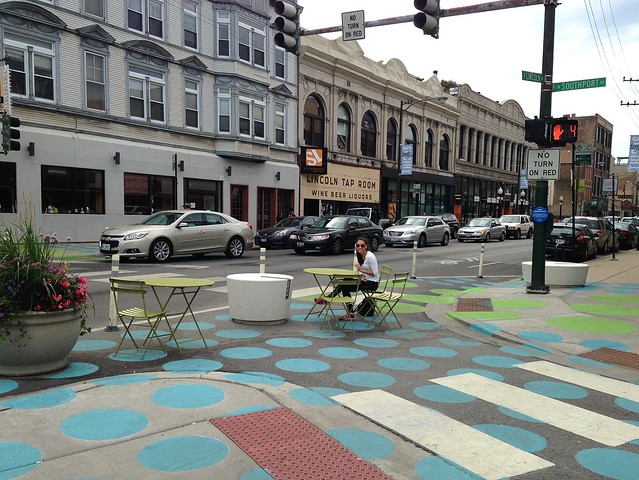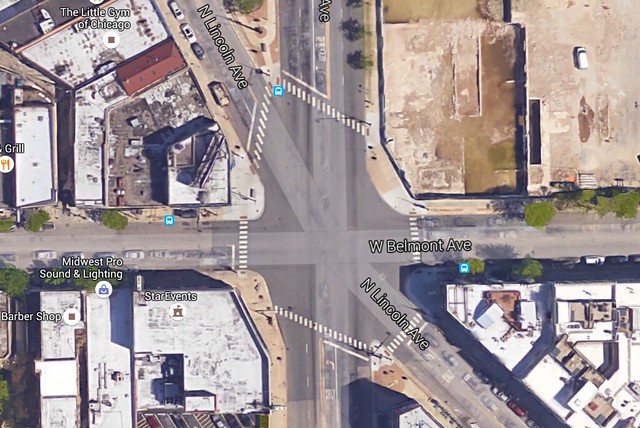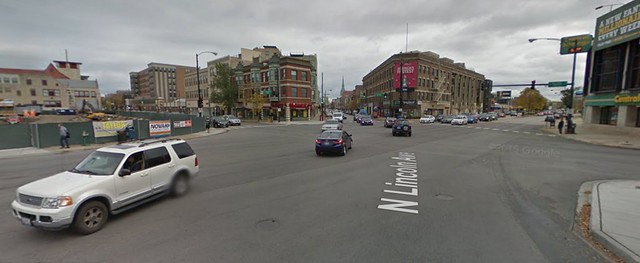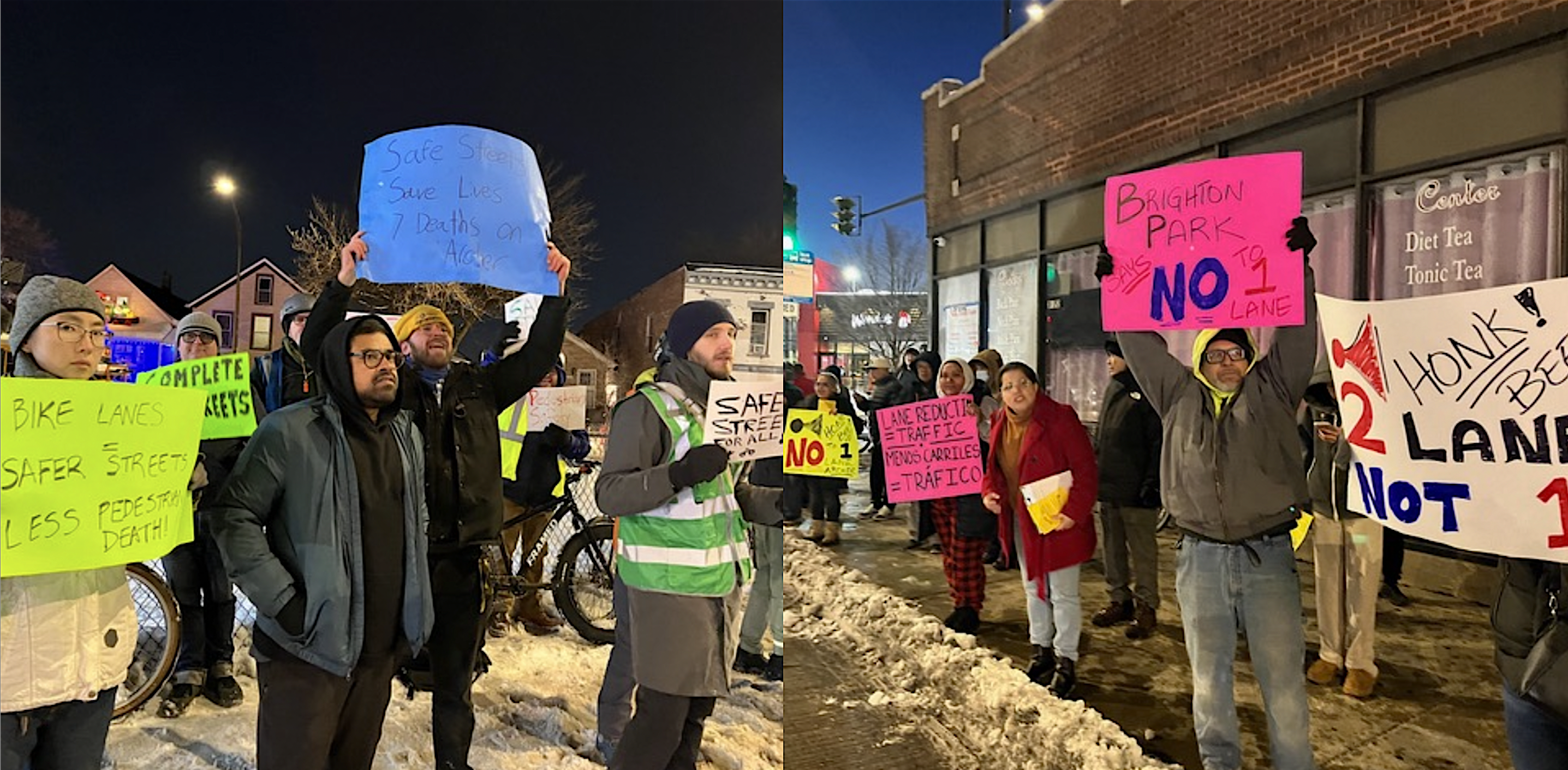The six-way intersection of Belmont, Ashland, and Lincoln in Lakeview is one of the most confusing and scariest intersections on the North Side, especially for pedestrians and bicyclists.
The north and south legs of Lincoln don’t line up properly. The six-way junction is a massive expanse of asphalt, roughly 150 feet across at its widest point, creating a long exposure time for cyclists on the diagonal street, a recommended bike route. Pedestrians are forced to make as many as three street crossings to get where they need to go, using long, skewed crosswalks.
Not surprisingly, the intersection has a high crash rate. According to Steven Vance’s Chicago Crash Browser, based on state collision statistics, from 2009 to 2013 there were 185 total crashes at the intersection, including 12 in which bicyclists were injured, and five in which pedestrians were injured. The junction is sure to become even more chaotic in early 2017 when a new Whole Foods opens at the northeast corner with a whopping 300-plus car parking spaces.
In an effort to increase safety for all road users, enhance walkability and reduce the “barrier effect” of the intersection, The Chicago Department of Transportation will be making some safety improvements. It’s part of a larger streetscape project that also includes making the Lincoln Hub placemaking pilot, located two blocks southeast at Wellington/Southport/Lincoln, a permanent – though scaled-back – feature of Lakeview.

CDOT will be holding a public hearing to discuss their plan next Tuesday, March 29, from 6-7:30 p.m. at St. Luke’s Church, 1500 West Belmont. Last Tuesday the department held a private meeting to outline the project with local aldermen Scott Waguespack, Tom Tunney, and Ameya Pawar, plus the Lakeview Chamber of Commerce and other neighborhood organizations.
Waguespack’s chief of Staff Paul Sajovec filled me in what was discussed at the recent meeting. CDOT considered making some fairly bold changes to Belmont/Ashland/Lincoln, including closing off Lincoln Avenue entirely in one direction or the other, Sajovec said. However, they ultimately decided to go with options that involve the least amount of changes to motor vehicle throughput, according to Sajovec.
It’s tempting to fault CDOT for prioritizing traffic flow over improvements that would maximize safety and walkability here. However, the changes to the intersection will require approval from the more conservative Illinois Department of Transportation. In addition, all three streets are bus routes (or will be, once the CTA’s #11 Lincoln route re-launches this year), so unless the redesign includes dedicated bus lanes, reducing throughput would slow down transit trips.
Moreover, from what Sajovec told me, some positive changes are planned. Curb extensions will be added to some of the six corners, shortening crossing distances for pedestrians. In addition, these will help reduce the kink in Lincoln.
Left turns from that diagonal street will be banned in both directions. That will allow bike lanes to be striped on Lincoln through the intersection, which will make pedaling across the vast expanse a little less nerve-wracking.

The left turn ban may drive a few more cars onto Barry, a block south of Belmont, and School, a block north, but Sajovec thinks the impact won’t be significant. “If you can’t turn left off of Lincoln at Belmont, you wouldn’t choose Lincoln as your route in the first place,” he argues.
Northbound drivers also will no longer be able to make a hard right turn southeast onto Lincoln, Sajovec said. In addition, a stop light will be added at Melrose, the next east-west street north of Belmont, to facilitate motorists entering and leaving the Whole Foods.
CDOT and the CTA considered implementing far-side bus stops, which can help buses from getting stuck at red lights, with curb bumpouts to ease boarding. However, only some of the intersection's bus stops will get this treatment, because it requires the elimination of parking spaces in an area with a high demand, Sajovec says.
CDOT considered implementing a pedestrian scramble signal phase at the intersection, which would have halted all car traffic while allowing pedestrians to cross in all direction, according to Sajovec. That idea was rejected as being too disruptive to car traffic flow.
The department also thought about striping continuous east-west intersections along Belmont that would have reduced the number of crossings for people on foot. That idea was thrown out as well.
On the bright side, the Lincoln Hub project, which eliminated dangerous slip lanes, shortened crossing distances and created new seating areas via colorful paint dots on the street and flexible poles, is slated to be set in concrete. To appease motorists, who have been grumbling ever since the street redesign debuted in spring 2015, the curb extensions will be somewhat smaller, to make it easier for through traffic to get around drivers waiting to make turns.
Sajovec said it hasn’t been determined whether the new, smaller bumpouts at Wellington/Southport/Lincoln will have seating, like the current ones do, but he says that possibility is still on the table.





